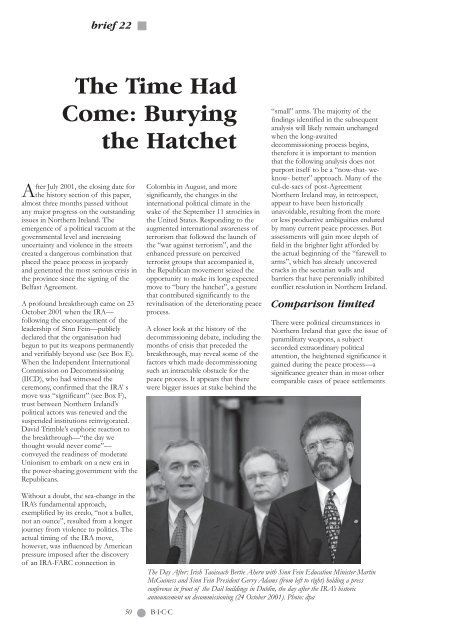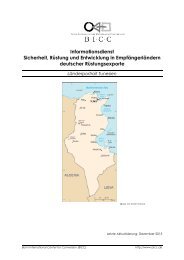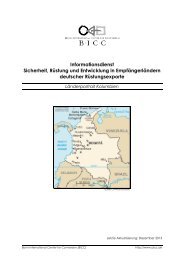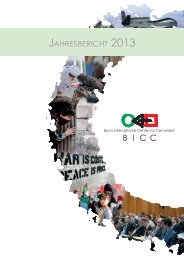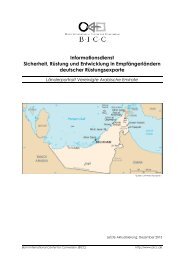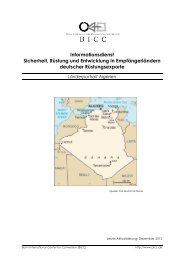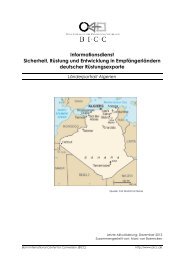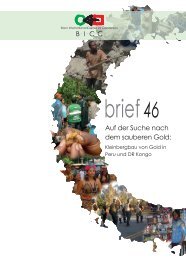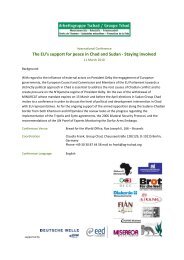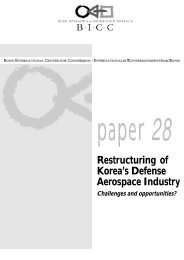English - BICC
English - BICC
English - BICC
Create successful ePaper yourself
Turn your PDF publications into a flip-book with our unique Google optimized e-Paper software.
ief 22<br />
The Time Had<br />
Come: Burying<br />
the Hatchet<br />
After July 2001, the closing date for<br />
the history section of this paper,<br />
almost three months passed without<br />
any major progress on the outstanding<br />
issues in Northern Ireland. The<br />
emergence of a political vacuum at the<br />
governmental level and increasing<br />
uncertainty and violence in the streets<br />
created a dangerous combination that<br />
placed the peace process in jeopardy<br />
and generated the most serious crisis in<br />
the province since the signing of the<br />
Belfast Agreement.<br />
A profound breakthrough came on 23<br />
October 2001 when the IRA—<br />
following the encouragement of the<br />
leadership of Sinn Fein—publicly<br />
declared that the organisation had<br />
begun to put its weapons permanently<br />
and verifiably beyond use (see Box E).<br />
When the Independent International<br />
Commission on Decommissioning<br />
(IICD), who had witnessed the<br />
ceremony, confirmed that the IRA’ s<br />
move was “significant” (see Box F),<br />
trust between Northern Ireland’s<br />
political actors was renewed and the<br />
suspended institutions reinvigorated.<br />
David Trimble’s euphoric reaction to<br />
the breakthrough—“the day we<br />
thought would never come”—<br />
conveyed the readiness of moderate<br />
Unionism to embark on a new era in<br />
the power-sharing government with the<br />
Republicans.<br />
Without a doubt, the sea-change in the<br />
IRA’s fundamental approach,<br />
exemplified by its credo, “not a bullet,<br />
not an ounce”, resulted from a longer<br />
journey from violence to politics. The<br />
actual timing of the IRA move,<br />
however, was influenced by American<br />
pressure imposed after the discovery<br />
of an IRA-FARC connection in<br />
Colombia in August, and more<br />
significantly, the changes in the<br />
international political climate in the<br />
wake of the September 11 atrocities in<br />
the United States. Responding to the<br />
augmented international awareness of<br />
terrorism that followed the launch of<br />
the “war against terrorism”, and the<br />
enhanced pressure on perceived<br />
terrorist groups that accompanied it,<br />
the Republican movement seized the<br />
opportunity to make its long expected<br />
move to “bury the hatchet”, a gesture<br />
that contributed significantly to the<br />
revitalisation of the deteriorating peace<br />
process.<br />
A closer look at the history of the<br />
decommissioning debate, including the<br />
months of crisis that preceded the<br />
breakthrough, may reveal some of the<br />
factors which made decommissioning<br />
such an intractable obstacle for the<br />
peace process. It appears that there<br />
were bigger issues at stake behind the<br />
50 B·I·C·C<br />
“small” arms. The majority of the<br />
findings identified in the subsequent<br />
analysis will likely remain unchanged<br />
when the long-awaited<br />
decommissioning process begins,<br />
therefore it is important to mention<br />
that the following analysis does not<br />
purport itself to be a “now-that- weknow-<br />
better” approach. Many of the<br />
cul-de-sacs of post-Agreement<br />
Northern Ireland may, in retrospect,<br />
appear to have been historically<br />
unavoidable, resulting from the more<br />
or less productive ambiguities endured<br />
by many current peace processes. But<br />
assessments will gain more depth of<br />
field in the brighter light afforded by<br />
the actual beginning of the “farewell to<br />
arms”, which has already uncovered<br />
cracks in the sectarian walls and<br />
barriers that have perennially inhibited<br />
conflict resolution in Northern Ireland.<br />
Comparison limited<br />
There were political circumstances in<br />
Northern Ireland that gave the issue of<br />
paramilitary weapons, a subject<br />
accorded extraordinary political<br />
attention, the heightened significance it<br />
gained during the peace process—a<br />
significance greater than in most other<br />
comparable cases of peace settlements<br />
The Day After: Irish Taoiseach Bertie Ahern with Sinn Fein Education Minister Martin<br />
McGuiness and Sinn Fein President Gerry Adams (from left to right) holding a press<br />
conference in front of the Dail buildings in Dublin, the day after the IRA’s historic<br />
announcement on decommissioning (24 October 2001). Photo: dpa


